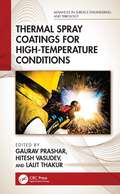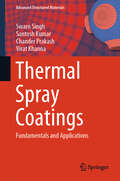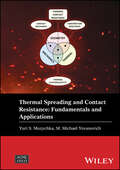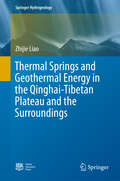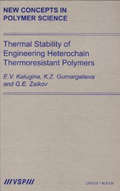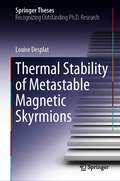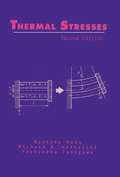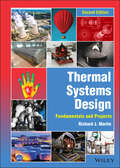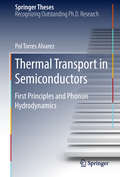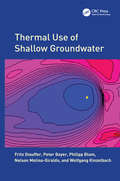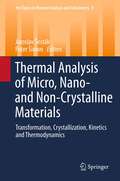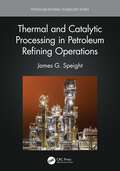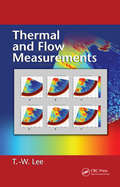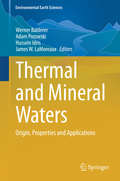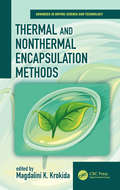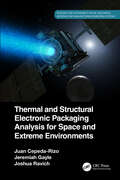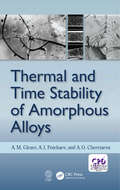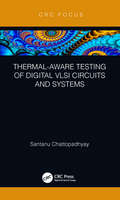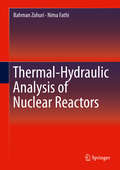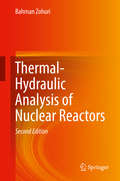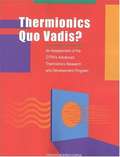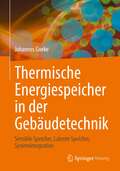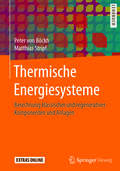- Table View
- List View
Thermal Spray Coatings for High-Temperature Conditions (Advances in Surface Engineering and Tribology)
by Lalit Thakur Hitesh Vasudev Gaurav PrasharThermal Spray Coatings for High-Temperature Conditions provides an in-depth analysis of thermal spray coatings covering a wide range of types and applications in aerospace, automotive, and heavy-duty equipment maintenance. It considers the various thermal spray processes available, including high-velocity oxy-fuel spraying, plasma spraying, and flame spraying.Focusing on the importance of surface preparation for thermal spray coatings, this book demonstrates the significance of establishing a strong bond between the substrate and the coating. It explores a range of surface preparation techniques like grit blasting and laser texturing. This book showcases the wide range of uses for thermal spray coatings, such as protecting against corrosion, enhancing wear resistance, preventing erosion, and prolonging the lifespan of industrial equipment.This book is intended for researchers and graduate students studying surface engineering, thermodynamics, high-temperature materials, and wear resistance.
Thermal Spray Coatings: Fundamentals and Applications (Advanced Structured Materials #232)
by Santosh Kumar Chander Prakash Virat Khanna Swarn SinghThis book provides a comprehensive review of the effects of key factors ranging from powder characteristics to process parameters, substrate preparation, and post-treatment methods on the coated substrate surface by different thermal spray techniques. Thermal spray techniques have gained significant attention in various industries due to their ability to deposit protective coatings on substrates. These coatings enhance the surface properties of substrates, such as wear resistance, corrosion resistance, and thermal insulation. However, the quality and performance of the coated substrate surface are influenced by several key factors. The book discusses the influence of parameters such as powder characteristics, process parameters, substrate preparation, and post-treatment methods on the coating microstructure, adhesion, and overall performance. The review aims to contribute to a better understanding of the factors that affect the coated substrate surface and provide insights for future research and optimization of thermal spray processes.
Thermal Spreading and Contact Resistance: Fundamentals and Applications (Wiley-ASME Press Series)
by Yuri S. Muzychka M. Michael YovanovichThermal Spreading and Contact Resistance: Fundamentals and Applications Single source reference on how applying thermal spreading and contact resistance can solve problems across a variety of engineering fields Thermal Spreading and Contact Resistance: Fundamentals and Applications offers comprehensive coverage of the key information that engineers need to know to understand thermal spreading and contact resistance, including numerous predictive models for determining thermal spreading resistance and contact conductance of mechanical joints and interfaces, plus detailed examples throughout the book. Written by two of the leading experts in the field, Thermal Spreading and Contact Resistance: Fundamentals and Applications includes information on: Contact conductance, mass transfer, transport from super-hydrophobic surfaces, droplet/surface phase change problems, and tribology applications such as sliding surfaces and roller bearings Heat transfer in micro-devices and thermal spreaders, orthotropic systems, and multi-source applications for electronics thermal management applications Fundamental principles, thermal spreading in isotropic half-space regions, circular flux tubes and disc spreaders, and rectangular flux channels and compound spreaders Systems with non-uniform sink plane conductance, transient spreading resistance, and contact resistance between both non-conforming and conforming rough surfaces Providing comprehensive coverage of the subject, Thermal Spreading and Contact Resistance: Fundamentals and Applications is an essential resource for mechanical, aerospace, and chemical engineers working on research in the fields of heat transfer, thermal management of electronics, and tribology, as well as thermal engineers and researchers in the field of thermal physics.
Thermal Springs and Geothermal Energy in the Qinghai-Tibetan Plateau and the Surroundings
by Zhijie LiaoThis book introduces readers to the rich and varied thermal springs of the Tibetan Plateau, which is steadily rising due to the collision of two continental plates. Readers will discover a wealth of information on boiling springs and hot springs, including their location and elevation, temperature, geological characteristics, and water chemical data, as well as tables on warm and tepid springs. Shedding new light on this vital supplement to hydroelectric resources in remote southwest China, the book will appeal to a broad relationship, from experts researching the Tibetan Plateau to companies specializing in geothermal exploration.
Thermal Stability of Engineering Heterochain Thermoresistant Polymers
by Gennady Zaikov Kalugina GumargalievaThis book presents investigation results of thermal transformations in thermoresistant polymers: polysulfones, polyester-imides, aliphatic-aromatic polyimides and polyamides, liquid-crystal aromatic co-polyesters, polyphenylquinoxalines at temperatures of materials and articles processing and operation.An important result of investigations is the d
Thermal Stability of Metastable Magnetic Skyrmions (Springer Theses)
by Louise DesplatThe energy cost associated with modern information technologies has been increasing exponentially over time, stimulating the search for alternative information storage and processing devices. Magnetic skyrmions are solitonic nanometer-scale quasiparticles whose unique topological properties can be thought of as that of a Mobius strip. Skyrmions are envisioned as information carriers in novel information processing and storage devices with low power consumption and high information density. As such, they could contribute to solving the energy challenge.In order to be used in applications, isolated skyrmions must be thermally stable at the scale of years. In this work, their stability is studied through two main approaches: the Kramers' method in the form of Langer's theory, and the forward flux sampling method. Good agreement is found between the two methods. We find that small skyrmions possess low internal energy barriers, but are stabilized by a large activation entropy. This is a direct consequence of the existence of stable modes of deformation of the skyrmion. Additionally, frustrated exchange that arises at some transition metal interfaces leads to new collapse paths in the form of the partial nucleation of the corresponding antiparticle, as merons and antimerons.
Thermal Stresses: Advanced Theory And Applications (Solid Mechanics And Its Applications Ser. #158)
by Naotake NodaThermal Stresses, 2nd Edition is the first book comprehensive volume on thermal stresses. It provides a sound grounding in the fundamental theory of thermal stresses as well as includes a multitude of applications. Many solved examples are included in the text, with numerous problems at the end of each chapter.The book starts with an introduction to the elementary theory, at the undergraduate level, and then progresses with the exposition of more advanced methods. The authors introduce the topics in a clear fashion, easy to grasp by students, engineers and scientists.
Thermal System Optimization: A Population-Based Metaheuristic Approach
by Vimal J. Savsani Vivek K. Patel Mohamed A. TawhidThis book presents a wide-ranging review of the latest research and development directions in thermal systems optimization using population-based metaheuristic methods. It helps readers to identify the best methods for their own systems, providing details of mathematical models and algorithms suitable for implementation. To reduce mathematical complexity, the authors focus on optimization of individual components rather than taking on systems as a whole. They employ numerous case studies: heat exchangers; cooling towers; power generators; refrigeration systems; and others. The importance of these subsystems to real-world situations from internal combustion to air-conditioning is made clear. The thermal systems under discussion are analysed using various metaheuristic techniques, with comparative results for different systems. The inclusion of detailed MATLAB® codes in the text will assist readers—researchers, practitioners or students—to assess these techniques for different real-world systems. Thermal System Optimization is a useful tool for thermal design researchers and engineers in academia and industry, wishing to perform thermal system identification with properly optimized parameters. It will be of interest for researchers, practitioners and graduate students with backgrounds in mechanical, chemical and power engineering.
Thermal Systems Design: Fundamentals and Projects
by Richard J. MartinThermal Systems Design Discover a project-based approach to thermal systems design In the newly revised Second Edition of Thermal Systems Design: Fundamentals and Projects, accomplished engineer and educator Dr. Richard J. Martin offers senior undergraduate and graduate students an insightful exposure to real-world design projects. The author delivers a brief review of the laws of thermodynamics, fluid mechanics, heat transfer, and combustion before moving on to a more expansive discussion of how to apply these fundamentals to design common thermal systems like boilers, combustion turbines, heat pumps, and refrigeration systems. The book includes design prompts for 14 real-world projects, teaching students and readers how to approach tasks like preparing Process Flow Diagrams and computing the thermodynamic details necessary to describe the states designated therein. Readers will learn to size pipes, ducts, and major equipment and to prepare Piping and Instrumentation Diagrams that contain the instruments, valves, and control loops needed for automatic functioning of the system. The Second Edition offers an updated look at the pedagogy of conservation equations, new examples of fuel-rich combustion, and a new summary of techniques to mitigate against thermal expansion and shock. Readers will also enjoy: Thorough introductions to thermodynamics, fluid mechanics, and heat transfer, including topics like the thermodynamics of state, flow in porous media, and radiant exchange A broad exploration of combustion fundamentals, including pollutant formation and control, combustion safety, and simple tools for computing thermochemical equilibrium when product gases contain carbon monoxide and hydrogen Practical discussions of process flow diagrams, including intelligent CAD, equipment, process lines, valves and instruments, and non-engineering items In-depth examinations of advanced thermodynamics, including customized functions to compute thermodynamic properties of air, combustion products, water/steam, and ammonia right in the user’s Excel workbook Perfect for students and instructors in capstone design courses, Thermal Systems Design: Fundamentals and Projects is also a must-read resource for mechanical and chemical engineering practitioners who are seeking to extend their engineering know-how to a wide range of unfamiliar thermal systems.
Thermal Transport in Semiconductors: First Principles and Phonon Hydrodynamics (Springer Theses)
by Pol Torres AlvarezStarting from a broad overview of heat transport based on the Boltzmann Transport Equation, this book presents a comprehensive analysis of heat transport in bulk and nanomaterials based on a kinetic-collective model (KCM). This has become key to understanding the field of thermal transport in semiconductors, and represents an important stride. The book describes how heat transport becomes hydrodynamic at the nanoscale, propagating very much like a viscous fluid and manifesting vorticity and friction-like behavior. It introduces a generalization of Fourier’s law including a hydrodynamic term based on collective behavior in the phonon ensemble. This approach makes it possible to describe in a unifying way recent experiments that had to resort to unphysical assumptions in order to uphold the validity of Fourier’s law, demonstrating that hydrodynamic heat transport is a pervasive type of behavior in semiconductors at reduced scales.
Thermal Use of Shallow Groundwater
by Fritz Stauffer Peter Bayer Philipp Blum Nelson Molina Giraldo Wolfgang KinzelbachThe thermal use of the shallow subsurface is increasingly being promoted and implemented as one of many promising measures for saving energy. A series of questions arises concerning the design and management of underground and groundwater heat extraction systems, such as the sharing of the thermal resource and the assessment of its long-term potent
Thermal analysis of Micro, Nano- and Non-Crystalline Materials
by Jaroslav Šesták Peter SimonThermal Analysis of Micro-, Nano- and Non-Crystalline Materials: Transformation, Crystallization, Kinetics, and Thermodynamics complements and adds to volume 8 Glassy, Amorphous and Nano-Crystalline Materials by providing a coherent and authoritative overview of cutting-edge themes in this field. In particular, the book focuses on reaction thermodynamics and kinetics applied to solid-state chemistry and thermal physics of various states of materials. Written by an international array of distinguished academics, the book deals with fundamental and historical aspects of phenomenological kinetics, equilibrium background of processes, crystal defects, non-stoichiometry and nano-crystallinity, reduced glass-transition temperatures and glass-forming coefficients, determination of the glass transition by DSC, the role of heat transfer and phase transition in DTA experiments, explanation of DTA/DSC methods used for the estimation of crystal nucleation, structural relaxation and viscosity behaviour in glass and associated relaxation kinetics, influence of preliminary nucleation and coupled phenomenological kinetics, nucleation on both the strongly curved surfaces and nano-particles, crystallization of glassy and amorphous materials including oxides, chalcogenides and metals, non-parametric and fractal description of kinetics, disorder and dimensionality in nano-crystalline diamond, thermal analysis of waste glass batches, amorphous inorganic polysialates and bioactivity of hydroxyl groups as well as reaction kinetics and unconventional glass formability of oxide superconductors. Thermal Analysis of Micro-, Nano- and Non-Crystalline Materials: Transformation, Crystallization, Kinetics, and Thermodynamics is a valuable resource to advanced undergraduates, postgraduates, and researches working in the application fields of material thermodynamics, thermal analysis, thermophysical measurements, and calorimetry.
Thermal and Catalytic Processing in Petroleum Refining Operations (Petroleum Refining Technology Series)
by James G. SpeightThis book presents the thermal and catalytic processes in refining. The differences between each type of process and the types of feedstock that can be used for the processes are presented. Relevant process data is provided, and process operations are fully described. This accessible guide is written for managers, professionals, and technicians as well as graduate students transitioning into the refining industry. Key Features: Describes feedstock evaluation and the effects of elemental, chemical, and fractional composition. Details reactor types and bed types. Explores the process options and parameters involved. Assesses coke formation and additives. Considers next generation processes and developments.
Thermal and Flow Measurements
by T.-W. LeeThermal and flow processes are ubiquitous in mechanical, aerospace and chemical engineering systems. Experimental methods including thermal and flow diagnostics are therefore an important element in preparation of future engineers and researchers in this field. Due to the interdisciplinary nature of experimentation, a fundamental guidance book is e
Thermal and Mineral Waters
by James W. Lamoreaux Werner Balderer Adam Porowski Hussein IdrisThis is a compilation of manuscripts on mineral and thermal waters of different areas of the world. This special volume is devoted to the 41st Meeting of the Commission on Mineral and Thermal Waters of International Association of Hydrogeologists (IAH-CMTW) held in Cairo, Egypt, in October 2009. The presentations collected and presented in this volume show the variety of aspects of mineral and thermal waters occurrence and utilization in different countries of the world with a special focus on Egypt, Iran, Ukraine, Poland, Russia and Australia.
Thermal and Nonthermal Encapsulation Methods (Advances in Drying Science and Technology)
by Magdalini KrokidaEncapsulation is a topic of interest across a wide range of scientific and industrial areas, from pharmaceutics to food and agriculture, for the protection and controlled release of various substances during transportation, storage, and consumption. Since encapsulated materials can be protected from external conditions, encapsulation enhances their stability and maintains their viability. This book offers a comprehensive review of conventional and modern methods for encapsulation. It covers various thermal and nonthermal encapsulation methods applied across a number of industries, including freeze drying, spray drying, spray chilling and spray cooling, electrospinning/electrospraying, osmotic dehydration, extrusion, air-suspension coating, pan coating, and vacuum drying. The book presents basic fundamentals, principles, and applications of each method, enabling the reader to gain extended knowledge. The choice of the most suitable encapsulation technique is based on the raw materials, the required size, and the desirable characteristics of the final products.
Thermal and Structural Electronic Packaging Analysis for Space and Extreme Environments (Resilience and Sustainability in Civil, Mechanical, Aerospace and Manufacturing Engineering Systems)
by Juan Cepeda-Rizo Jeremiah Gayle Joshua RavichHave you ever wondered how NASA designs, builds, and tests spacecrafts and hardware for space? How is it that wildly successful programs such as the Mars Exploration Rovers could produce a rover that lasted over ten times the expected prime mission duration? Or build a spacecraft designed to visit two orbiting destinations and last over 10 years when the fuel ran out? This book was written by NASA/JPL engineers with experience across multiple projects, including the Mars rovers, Mars helicopter, and Dawn ion propulsion spacecraft in addition to many more missions and technology demonstration programs. It provides useful and practical approaches to solving the most complex thermal-structural problems ever attempted for design spacecraft to survive the severe cold of deep space, as well as the unforgiving temperature swings on the surface of Mars. This is done without losing sight of the fundamental and classical theories of thermodynamics and structural mechanics that paved the way to more pragmatic and applied methods such finite element analysis and Monte Carlo ray tracing, for example. Features: Includes case studies from NASA’s Jet Propulsion Laboratory, which prides itself in robotic exploration of the solar system, as well as flyting the first cubeSAT to Mars. Enables spacecraft designer engineers to create a design that is structurally and thermally sound, and reliable, in the quickest time afforded. Examines innovative low-cost thermal and power systems. Explains how to design to survive rocket launch, the surfaces of Mars and Venus. Suitable for practicing professionals as well as upper-level students in the areas of aerospace, mechanical, thermal, electrical, and systems engineering, Thermal and Structural Electronic Packaging Analysis for Space and Extreme Environments provides cutting-edge information on how to design, and analyze, and test in the fast-paced and low-cost small satellite environment and learn techniques to reduce the design and test cycles without compromising reliability. It serves both as a reference and a training manual for designing satellites to withstand the structural and thermal challenges of extreme environments in outer space.
Thermal and Time Stability of Amorphous Alloys
by A. Glezer A. Potekaev A. CheretaevaThis reference is dedicated to the problem of time-temperature stability of amorphous (non-crystalline) metal alloys with strongly nonequilibrium structure and unique physical and mechanical properties that are obtained by quenching from the melt at a rate that exceeds one millions of degrees c.o.s. second. As a stability test, the behavior of the plasticity of amorphous alloys is studied. The book examines the fundamental characteristics of amorphous alloys, the basic laws of structural relaxation, generalized information about the phenomenon of the ductile-brittle transition (temper embrittlement), the development of physically justified methods of predicting the stability of the properties, and provides information about the attempts of controlling the structure for the purpose of suppressing or deceleration of the ductile-brittle transition and, as a consequence, increasing the temperature and temporal stability of the amorphous state.
Thermal-Aware Testing of Digital VLSI Circuits and Systems
by Santanu ChattopadhyayThis book aims to highlight the research activities in the domain of thermal-aware testing. Thermal-aware testing can be employed both at circuit level and at system level Describes range of algorithms for addressing thermal-aware test issue, presents comparison of temperature reduction with power-aware techniques and include results on benchmark circuits and systems for different techniques This book will be suitable for researchers working on power- and thermal-aware design and the testing of digital VLSI chips
Thermal-Hydraulic Analysis of Nuclear Reactors
by Bahman Zohuri Nima FathiThis text covers the fundamentals of thermodynamics required to understand electrical power generation systems and the application of these principles to nuclear reactor power plant systems. It is not a traditional general thermodynamics text, per se, but a practical thermodynamics volume intended to explain the fundamentals and apply them to the challenges facing actual nuclear power plants systems, where thermal hydraulics comes to play. Written in a lucid, straight-forward style while retaining scientific rigor, the content is accessible to upper division undergraduate students and aimed at practicing engineers in nuclear power facilities and engineering scientists and technicians in industry, academic research groups, and national laboratories. The book is also a valuable resource for students and faculty in various engineering programs concerned with nuclear reactors. This book also: Provides extensive coverage of thermal hydraulics with thermodynamics in nuclear reactors, beginning with fundamental definitions of units and dimensions, thermodynamic variables, and the Laws of Thermodynamics progressing to sections on specific applications of the Brayton and Rankine cycles for power generation and projected reactor systems design issues Reinforces fundamentals of fluid dynamics and heat transfer; thermal and hydraulic analysis of nuclear reactors, two-phase flow and boiling, compressible flow, stress analysis, and energy conversion methods Includes detailed appendices that cover metric and English system units and conversions, detailed steam and gas tables, heat transfer properties, and nuclear reactor system descriptions
Thermal-Hydraulic Analysis of Nuclear Reactors
by Bahman ZohuriThis text covers the fundamentals of thermodynamics required to understand electrical power generation systems and the application of these principles to nuclear reactor power plant systems. It is not a traditional general thermodynamics text, per se, but a practical thermodynamics volume intended to explain the fundamentals and apply them to the challenges facing actual nuclear power plants systems, where thermal hydraulics comes to play. Written in a lucid, straight-forward style while retaining scientific rigor, the content is accessible to upper division undergraduate students and aimed at practicing engineers in nuclear power facilities and engineering scientists and technicians in industry, academic research groups, and national laboratories. The book is also a valuable resource for students and faculty in various engineering programs concerned with nuclear reactors. This book also: Provides extensive coverage of thermal hydraulics with thermodynamics in nuclear reactors, beginning with fundamental definitions of units and dimensions, thermodynamic variables, and the Laws of Thermodynamics progressing to sections on specific applications of the Brayton and Rankine cycles for power generation and projected reactor systems design issues Reinforces fundamentals of fluid dynamics and heat transfer; thermal and hydraulic analysis of nuclear reactors, two-phase flow and boiling, compressible flow, stress analysis, and energy conversion methods Includes detailed appendices that cover metric and English system units and conversions, detailed steam and gas tables, heat transfer properties, and nuclear reactor system descriptions
Thermally Stable and Flame Retardant Polymer Nanocomposites
by Vikas MittalPolymer nanocomposites have revolutionised material performance, most notably in the plastics, automotive and aerospace industries. However, in order to be commercially viable, many of these materials must withstand high temperatures. In this book, leaders in the field outline the mechanisms behind the generation of suitable polymer systems, pulling together recent research to provide a unified and up-to-date assessment of recent technological advancements. The text is divided into two clear sections, introducing the reader to the two most important requirements for this material type: thermal stability and flame retardancy. Special attention is paid to practical examples, walking the reader through the numerous commercial applications of thermally stable and flame retardant nanocomposites. With a strong focus on placing theory within commercial context, this unique volume will appeal to practitioners as well as researchers.
Thermionics Quo Vadis?: An Assessment of the DTRA's Advanced Thermionics Research and Development Program
by Technology Committee on Thermionic ResearchThis report evaluates the Defense Threat Reduction Agency prior and present sponsored efforts; assess the present state of the art in thermionic energy conversion systems; assess the technical challenges to the development of viable thermionic energy conversion systems for both space and terrestrial applications; and recommend a prioritized set of objectives for a future research and development program for advanced thermionic systems for space and terrestrial applications.
Thermische Energiespeicher in der Gebäudetechnik: Sensible Speicher, Latente Speicher, Systemintegration
by Johannes GoekeDie Speicherung von thermischer Energie in Form von Wärme und Kälte steht im Mittelpunkt dieses Buches. Inhalt sind die Themenbereiche wassergefüllte Speicher mit sensibler Wärme, latente Wärme-/Kältespeicher mit Phasenwechsel-Materialien sowie das Gebäude als thermischer Speicher. Dazu kommen Anwendungen im Bereich der Gebäude und Quartiere. Dabei liegt der Focus immer wieder auf der Belade- und Entladedynamik der unterschiedlichen Speichertypen.
Thermische Energiesysteme: Berechnung klassischer und regenerativer Komponenten und Anlagen
by Peter Von Böckh Matthias StripfDas Buch behandelt alle wesentlichen Aspekte zur grundlegenden Berechnung thermischer Energiesysteme. Es versetzt Studierende und Ingenieure in die Lage, reale Komponenten und Systeme tats#65533;chlich zu berechnen und zu konstruieren und ist damit eine ideale Fortsetzung der grundlagenorientierten B#65533;cher zur Thermodynamik, Fluidmechanik und W#65533;rme#65533;bertragung. Neben den klassischen Komponenten und Anlagen zur Energieversorgung werden auch die an Bedeutung gewinnenden Technologien, wie Windkraftanlagen und W#65533;rmepumpen im Detail behandelt. Alle Beispiele sind als Mathcad-Programme im Internet herunterladbar, ebenso wichtige Diagramme und Programme zur Berechnung der Stoffwerte. Die Zielgruppen - Studierende des Maschinenbaus und der Verfahrenstechnik - Planer und Entwickler im Bereich Thermische Energiesysteme
